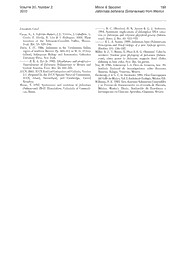
Two New Species of Cryptocarya (Lauraceae) from Panama and Ecuador PDF
Preview Two New Species of Cryptocarya (Lauraceae) from Panama and Ecuador
Two New Species of Cryptocarya (Lauraceae) from Panama and Ecuador Pedro Luis Rodrigues de Moraes Universidade Estadual de Feira de Santana, BR-116 Km 3, Campus Universitario, 44031-460, Feira de Santana, Bahia, Brazil, [email protected] Henk van der Werff Missouri Botanical Garden, P.0. Box 299, St. Louis, Missouri 63166-0299. U.S.A. [email protected] Abstract. Two new species of Cryptocarya R. Br., several additional species of Cryptocarya from C. panamensis P. L. R. Moraes & van der Werff, from Bolivia, Costa Rica, Ecuador, Peru, and Venezuela, van der Werff, from Napo, Ecuador, are described and flowering material is collected. It is worth mentioning illustrated. Additionally, the occurrence of C. guia- that no specimen of Cryptocarya has been found nensis Meisn. in Ecuador is here reported for the first among the Lauraceae collections at COAH and COL. are unlike other Neotropical Lauraceae, and several Icacinaceae, and Nyctaginaceae. Cryptocarya R. Br. is one of the larger pantropical genera of the Lauraceae, present in South America, New Species of Cryptocarya Oceania, with an estimated 350 species (van der Werff, 1992, 2008; Rohwer, 1993). The Brazilian der Werff, sp. nov. TYPE: Panama. Colon: Teck species of Cryptocarya were recently revised by Cominco Petaquilla mining concession, forested Moraes (2007), who recognized 13 species. Until the slopes along ridge rd., 08°49'56"N, 80°41'05"W, present, except for the Chilean species C. alba ca. 250 m, 7 Mar. 2008 (fl.), G. McPherson 20456 (Molina) Looser and the French Guianan C. guianensis (holotype, PMA; isotypes, MO, SPSF). Figure 1. Meisn., the American species of the genus were from other genera of the Lauraceae by its bisexual and trimerous flowers, which are very typical in shape tube and the ovary immersed in the tube, six equal to subequal tepals, nine fertile stamens h disporangi- Trees, to 20 m; branches cylindrical, with lenticels; ate anthers, staminal glands only branchlets ca. 2.5 mm diam., ca. 5 cm below terminal androecial whorl), and by the characteri : fruit that bud, chestnut-brown to dark brown, angular at the tips, becoming terete toward the base of the preparation of the treatment of Cryptocarya from branchlets, slightly rugose, glabrous, shiny, with Brazil by the first author, several extra-Brazilian lenticels toward the base; terminal buds minute, ovoid, pubescent, hairs white to light yellow, ap- the Ecuadorian species presented below. An adi pressed. buds enclosed by concave scales, these tional new species collected recently in Panama glabrescent to ciliate. Petioles dark brown, 5-8 X ca. also described in this contribution, and C. guianensis 1 mm, canaliculate above, rounded below, rugose, is reported for the first time from Ecuador. As stated glabrous; leaves alternate, elliptic to ovate, 4.5-11.4 by van der Werff and Richter (1996), our lack of X 1.9-4.3 cm, chartaceous; young leaves glabrous knowledge of species numbers and distribution in the adaxially, glabrescent abaxially, adult leaves glabrous Lauraceae is related to the fact that many species are to locate and to collect. Flowers are still lacking for Novon 20: 190-194. Published on 9 June 2010. doi: 10.3417/2009005
